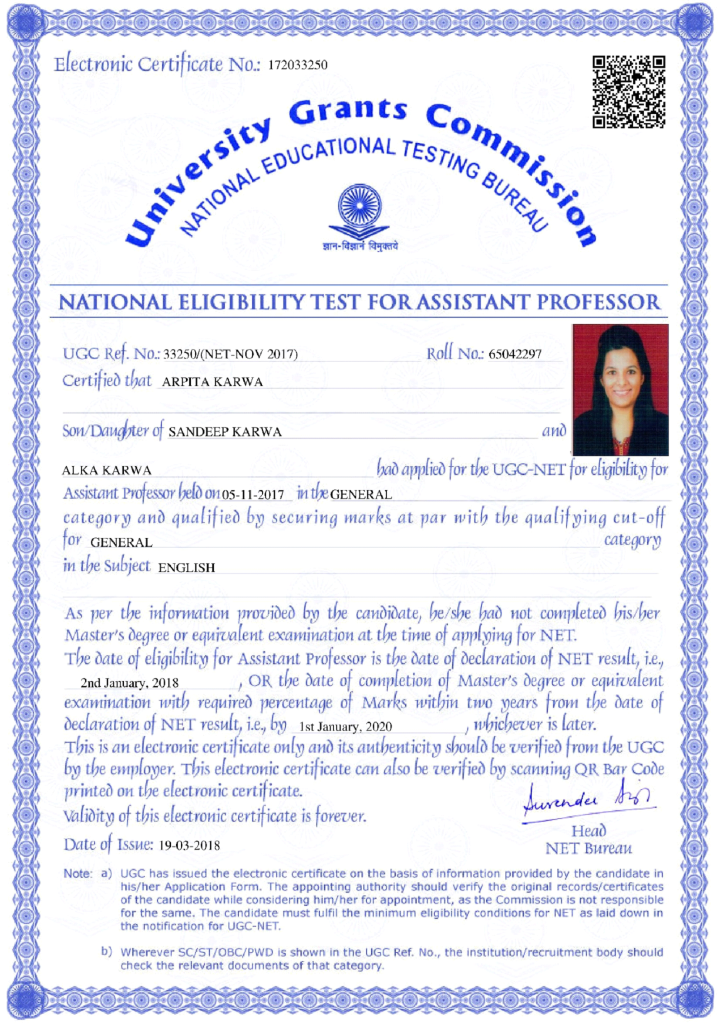December 2009 : Paper 2
October 18, 2022 2025-10-13 12:00December 2009 : Paper 2
December 2009 : Paper 2
1. A classical influence on Ben Jonson’s Volpone is
(A) Juvenal
(B) Aristophanes
(C) Plautus
(D) Terence
Answer: B
2. Kipling’s “The White Man’s Burden” is addressed to
(A) The American imperial mission in the Philippines.
(B) The Belgian colonial expansion in the Congo.
(C) The British Imperial presence in Nigeria.
(D) The British colonial entry into Afghanistan.
Answer: A
3. Poetry : A Magazine of Verse was founded by Harriet Monroe in
(A) 1922
(B) 1920
(C) 1918
(D) 1912
Answer: D
4. Who among the following was Geoffrey Chaucer’s contemporary ?
(A) Thomas Chatterton
(B) John Gower
(C) Thomas Shadwell
(D) John Gay
Answer: B
5. Which of the following is NOT written by Walter Scott ?
(A) Ivanhoe
(B) Lady of the Lake
(C) Heart of Midlothian
(D) The English Mail Coach
Answer: D
6. “Provincializing Europe” is a concept propounded by
(A) Edward Said
(B) Paul Gilroy
(C) Abdul R. Gurnah
(D) Dipesh Chakravarty
Answer: D
7. The earliest tract on feminism is
(A) Simone de Beauvoir’s The Second Sex
(B) Virginia Woolf’s A Room of One’s Own
(C) Mary Wollstonecraft’s A Vindication of the Rights of Woman
(D) Mary Astell’s A Serious Proposal to the Ladies
Answer: D
8. Match the imaginary location with its creator :
1. Emily Bronte
2. Thomas Hardy
3. Lowood Parsonage
4. Charles Dickens
5. Wessex
6. Egdon Heath
7. Coketown
8. Charlotte Bronte
(A) 1-7 2-5 4-6 3-8
(B) 1-6 2-5 3-8 4-7
(C) 1-5 2-6 3-8 4-7
(D) 2-5 1-7 3-4 6-8
Answer: B
9. Which Chaucerian text parodies Dante’s The Divine Comedy ?
(A) The Canterbury Tales
(B) The Book of the Duchess
(C) The House of Fame
(D) Legend of Good Women
Answer: C
10. Essays of Elia was published in
(A) 1800
(B) 1823
(C) 1827
(D) 1850
Answer: B
11. Which of the following is an example of homosexual fiction ?
(A) The Well of Loneliness
(B) Maurice
(C) Orlando
(D) The Ballad of the Reading Gaol
Answer: A
12. W.B. Yeat’s “Easter 1916” is
(A) a response to a major political uprising
(B) a reminiscence of his visit to a nursery school
(C) a love poem for Maud Gonne
(D) an ode to his native country
Answer: A
13. William Empson’s Seven Types of Ambiguity is
(A) A structuralist study of narrative
(B) A piece of psychoanalytic criticism
(C) A study of the media
(D) An analysis of poetic ambivalence
Answer: D
14. Who among the following is associated with the ideology of Utilitarianism ?
(A) J.A. Froude
(B) Charles Kingsley
(C) J.S. Mill
(D) Cardinal Newman
Answer: C
15. The ‘Condition of England’ literature refers to
(A) The literature written by the labour class.
(B) The literature of England extolling living conditions.
(C) The literature of England depicting the vulnerability of labour classes.
(D) The literature of England depicting the imperial projects abroad.
Answer: C
16. Philip Sidney wrote An Apology for Poetry in immediate response to
(A) Plato’s Republic
(B) Aristotle’s Poetics
(C) Stephen Gosson’s The School of Abuse
(D) Jeremy Collier’s Immorality and Profaneness of the English Stage.
Answer: C
17. Silence ! The Court is in Session is a _________ play translated into English.
(A) Gujarati
(B) Bengali
(C) Marathi
(D) Kannada
Answer: C
18. Arrange the following in ascending order in terms of size :
1. epic 2. epigram 3. stanza 4. sonnet
(A) 1 2 3 4
(B) 2 1 3 4
(C) 2 3 4 1
(D) 1 3 4 2
Answer: C
19. “Fail I alone in words and deeds ?/Why, all men strive and who succeeds ?” These lines are from
(A) “Rabbi Ben Ezra”
(B) “Fra Lippo Lippi”
(C) “Caliban upon Setebos”
(D) “The Last Ride Together”
Answer: D
20. Dr. Johnson’s “The Vanity of Human Wishes” expresses
(A) Epicureanism
(B) Humanism
(C) Stoicism
(D) Cynicism
Answer: D
21. “A trivial comedy for serious people” was the subtitle for
(A) Everyman in His Humour
(B) Blythe Spirit
(C) The Way of the World
(D) The Importance of Being Earnest.
Answer: D
22. Which famous elegy closes with the following lines ?
In the deserts of the heart/Let the healing fountain start,/In the prison of his days,/ Teach the free man how to praise.”
(A) In Memoriam
(B) Thyrsis
(C) “In Memory of W.B. Yeats”
(D) “Verses on the Death of T.S. Eliot”
Answer: C
23. The Temple is a collection of poems by
(A) Thomas Carew
(B) Robert Herrick
(C) George Herbert
(D) Richard Crashaw
Answer: C
24. Ben Jonson’s comedies are
(A) Volpone, Bartholomew Fair, The Shoemaker’s Holiday
(B) Volpone, The Alchemist, Epicoene
(C) Volpone, The Alchemist, The Knight of the Burning Pestle
(D) Volpone, Epicoene, The Shoemaker’s Holiday
Answer: B
25. What is ‘L’ Allegro’s’ companion piece called ?
(A) Lamia
(B) Hyperion
(C) Il Penseroso
(D) Thyrsis
Answer: C
26. Match the character with the novel :
1. Caddy
2. Lennie
3. Jake Barnes
4. Tommy Wilhelm
5. The Sound and the Fury
6. Of Mice and Men
7. The Sun Also Rises
8. Seize the Day
Codes :
(A) 1-5 2-6 3-7 4-8
(B) 2-7 1-8 3-5 4-6
(C) 3-5 4-6 2-8 1-7
(D) 4-5 3-8 2-7 1-8
Answer: A
27. Who among the following writers belonged to the American Beat Movement ?
(A) Allen Ginsberg
(B) Mark Beard
(C) Isaac McCaslih
(D) Charles Beard
Answer: A
28. “The Lost Generation” is a name applied to the disillusioned intellectuals and aesthetes of the years following the First World War. Who called them “The Lost Generation” ?
(A) H.L. Mencken
(B) Willa Cather
(C) Jack London
(D) Gertrude Stein
Answer: D
29. Hyperbole is
1. an extravagant exaggeration
2. a racist slur
3. a metrical skill
4. a figure of speech
(A) 1 is correct
(B) 1 and 4 are correct
(C) 1 and 3 are correct
(D) 3 is correct
Answer: B
30. “Imagined Communities” is a concept propounded by
(A) Benedict Anderson
(B) Homi Bhabha
(C) Aijaz Ahmed
(D) Partha Chatterjee
Answer: A
31. The New Historicists include
(A) Greenblatt, Showalter, Montrose
(B) Greenblatt, Sinfield, Butler
(C) Greenblatt, Montrose, Goldberg
(D) Williams, Greenblatt, Belsey
Answer: C
32. Wallace Stevens’ “The Man with the Blue Guitar” may be linked to the work of the following artist :
(A) Modigliani
(B) Chagall
(C) Picasso
(D) Cezanne
Answer: C
33. The author of Gender Trouble is
(A) Elaine Showalter
(B) Helene Cixous
(C) Michele Barrett
(D) Judith Butler
Answer: D
34. The structural analysis of signs was practised by
(A) Michel Foucault
(B) Jacques Lacan
(C) Julia Kristeva
(D) Roland Barthes
Answer: D
35. Which of the following is a spoof of a Gothic novel ?
(A) Frankenstein
(B) Northanger Abbey
(C) Castle of Otranto
(D) Mysteries of Udolfo
Answer: B
36. The “madwoman in the attic” is a specific reference to
(A) The narrator of “Goblin Market”
(B) Augusta Egg’s 1858 narrative painting
(C) The Heroine of The Yellow Wallpaper
(D) Bertha Mason of Jane Eyre
Answer: D
37. Assertion (A) : Dr Johnson’s The Lives of the Poets carries critical and biographical studies of poets he admired. It does not, however, carry a life of William Wordsworth.
Reason (R) : Dr. Johnson singled out poets whom he not only admired but also adored. This explains his omission of Wordsworth.
(A) (A) is wrong but (R) is correct.
(B) (A) is true but (R) is false.
(C) (A) and (R) are true.
(D) Neither (A) nor (R) is true.
Answer: D
38. What is the correct chronological sequence of the following ?
(A) Moll Flanders, Pamela, Joseph Andrews, Tristram Shandy
(B) Joseph Andrews, Tristram Shandy, Pamela, Moll Flanders
(C) Tristram Shandy, Moll Flanders, Pamela, Joseph Andrews
(D) Pamela, Moll Flanders, Joseph Andrews, Tristram Shandy
Answer: A
39. “How can what an Englishman believes be heresy ? It is a contradiction in terms.” This means
1. An Englishman does not know what heresy is.
2. An Englishman has no beliefs.
3. And, therefore, there is no question of his heresy.
4. And, therefore, there cannot be any question of his acting his beliefs.
(A) 1 and 4 are correct
(B) 2 and 1 are correct
(C) 1 and 3 are correct
(D) 2 and 4 are correct
Answer: C
40. Which of the following is an essentially Freudian concept ?
(A) Archetype
(B) The Uncanny
(C) The Absurd
(D) The Imaginary
Answer: B
41. He wrote an essay called “Conrad’s Darkness” where he praises the earlier writer for offering him a vision of the world’s “half-made societies’. Identify the writer.
(A) Chinua Achebe
(B) V.S. Naipaul
(C) Salman Rushdie
(D) Ngugi wa Thiongo
Answer: B
42. “Magic Realism” is closely associated with
(A) Italo Calvino
(B) Gabriel Garcia Marquez
(C) Anita Desai
(D) Rohinton Mistry
Answer: B
43. Who among the following combines anthropology, history and fiction ?
(A) Kamala Markandya
(B) Mulk Raj Anand
(C) Upmanyu Chatterjee
(D) Amitav Ghosh
Answer: D
44. Which of the following is NOT a Partition novel ?
(A) Train to Pakistan
(B) Sunlight on a Broken Column
(C) The Shadow Lines
(D) In Custody
Answer: B
45. Which of the following options is correct ?
(i) Transcendentalism was a philosophical and literary movement.
(ii) It flourished in the Southern States of America in the 19th century.
(iii) It was a reaction against 18th century rationalism and the skeptical philosophy of Locke.
(iv) Among the major texts of Transcendentalist thought are the essays of Emerson, Thoreau’s Walden and the writings of Margaret Fuller.
(A) (i) and (iv) are correct.
(B) (ii) and (iii) are correct.
(C) (iii) and (iv) are correct.
(D) (iv) is correct.
Answer: A
Read the following passage carefully, and select the right answers from the alternatives givenbelow in the question 46 to 50 :
It would be more accurate to say that discourse, rather than language, plays a crucial part in structuring our experience. The whole idea of ‘language’ is something of a fiction : what we normally refer to as ‘language’ can more realistically be seen as heterogeneous collection of discourses. Each of us has access to a range of discourses, and it is these different discourses which give us access to, or enable us to perform, different ‘selves’. A discourse can be conceptualized as a ‘system of statements which cohere around common meanings and values’. So, for example, in contemporary Britain there are discourses which can be labelled ‘conservative’ – that is, discourses which emphasize values and meanings where the status quo is cherished : and there are discourses which can be labeled ‘patriarchal’ – that is, discourses which emphasize meanings and values which assume the superiority of males. Dominant discourses such as these appear ‘natural’ : they are powerful precisely because they are able to make invisible the fact that they are just one among many different discourses.
Theorizing language in this way is still new in linguistics (to the extent that many linguists would not regard analysis in terms of discourses as being part of linguistics). One of the advantages of talking about discourses rather than about language is that the concept ‘discourse’ acknowledges the value-laden nature of language. There is no neutral discourse : whenever we speak we have to choose between different systems of meaning, different sets of values. This process allows us to show how language is implicated in our construction of different ‘selves’ : different discourses position us in different ways in relation to the world.
46. Which of the following is True in the light of this passage ?
(A) Language is inaccurate.
(B) Discourse is accurate.
(C) Language comprises discourse.
(D) Discourse comprises language.
Answer: C
47. What words/phrases suggest the plurality of discourse in this passage ?
I. different selves
II. range
III. system of statements
IV. heterogeneous collection
(A) II and IV
(B) II and III
(C) III and IV
(D) I
Answer: A
48. Having called language “something of a fiction”, how does the author suggest its opposite ? By using the phrase
(A) conceptualized as a system
(B) more accurate to say
(C) range of discourses
(D) more realistically be seen
Answer: D
49. Which among the following statements is NOT true ?
(A) Conservative discourses plead for the status quo.
(B) Patriarchal discourses privilege male values.
(C) Dominant discourses are natural.
(D) Dominant discourses seem natural.
Answer: C
50. What does this passage plead for ?
(A) Theorizing language in a new way.
(B) Theorizing language in terms of discourses.
(C) Studying language as discourse.
(D) Studying discourse as language.
Answer: B
















